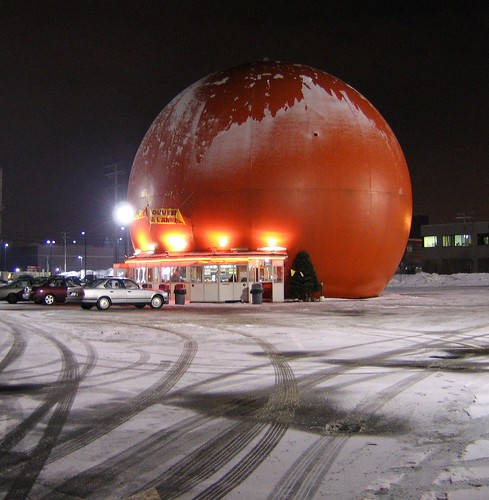
The Orange Julep. Photo by afternoon_sunlight
Montreal has lost one of its more remarkable pieces of kitsch architecture. Today, the Canada Motel, a 47-year-old landmark on Taschereau Blvd. on the South Shore, closed its doors for good.
The motel, topped by a giant neon sign, is designed in the style of a typical Quebec farmhouse, and it’s surrounded by old habitant-style cottages containing rooms with themes like “lumberjack” and “garage.” Roxanne Arsenault, an UQÀM student who is writing her master’s thesis on kitsch architecture, has launched a petition to have Longueuil designate the building as an historic structure. She has been joined in her fight by Heritage Montreal and even La Presse offered its support: “Sauvons le motel Canada!” cried a recent headline.
Montreal has a wealth of kitschy commercial architecture from the 1950s and 60s, but much of it is in danger. Few of these kétaine buildings are protected from demolition, including many motels, old fast-food restaurants, advertising structures like the Guaranteed Milk Bottle and even well-known landmarks like the Orange Julep on Decarie. Ben’s, an example of kitsch par excellence, will soon be demolished — or, at best, gutted — for a new condo or office tower.
Last August, Radio-Canada ran a documentary on Montreal’s kitsch architecture and the efforts being made to save it. Roxanne Arsenault makes an appearance, and she counts the Jardin Tiki, a Chinese restaurant on Sherbrooke St. near the Olympic Village, among Montreal’s most endangered kitsch buildings. Other important ones include the Orange Julep and nearby Ruby Foo’s, a Chinese-themed motel and buffet built in the 1960s, when Decarie north of Queen Mary was a popular cruising strip.
Growing up in Calgary, where one of the city’s most enduring icons — the Calgary Tower, an orangey-red observation tower built in 1967 — is a brilliant example of kitsch, I can definitely understand the fascination with and desire to save these buildings. But preserving them is more complicated than it might seem. Unlike other styles of architecture, their appeal rests as much in their spirit as their appearance. Ben’s, without its formica tables, linoleum floor and Poet’s Corner, is little more than a minor example of streamline architecture. The Orange Julep can only function as a fast-food restaurant.
But there are good models of kitsch preservation, like Wildwood, a New Jersey beach town that was a favourite vacation spot for Quebeckers in the 1960s. Blessed with a large collection of motels (including the Quebec Motel and the Montreal Inn) designed in a style known in the United States as “doo wop architecture,” preservation activists in Wildwood have taken to saving old signs, furniture, even toilets. New Jersey has given heritage designation to a number of motels, which has opened up federal preservation dollars. Wildwood business owners have even discovered that kitsch is good for business, as tourists return to Wildwood not only for the beach, but for its retro atmosphere.
Montreal might be well-suited to capitalize on a similar trend. In a review of the city’s kitsch architecture in Canadian Architect magazine, Elsa Lam detected an undercurrent of kitsch in everything from early twentieth-century triplexes to new structures like the multicoloured Palais des congrès.
That leads me to ask: what are your favourite examples of kitschy architecture in Montreal?

3 comments
Salle de quilles Rose Bowl, on St-Jacques, must be one of my favourites. In fact, the whole boulevard from Decarie down to where it intersects with highway 20 is lined up with interesting buildings of the kitsch type.
Yes! Let’s save our kitsch architecture!! As a huge fan of 1960 architecture, I want to preserve these wonderful pieces of architecture. Like the 250 year-old stone farmhouse, they tell an important part of our architectural history. Unfortunately, I think that my opinion doesn’t stand out in the masses. As we became a car-oriented society, most of these charming structures sprung up in our new landscapes, demolishing these structures makes us forget an important element of our cultural identity as North American consumers, and even of the North American identity! I’m ready to chain myself to theses structures… Who’s with me!
I am much more ambigious about kitch architecture, and particularly its setting (land use) than the above posters. Sure, I’m aware that societies are not protective enough of the recent past (witness thoughtless demolitions of Victorian and deco architecture) but at the same time, the last thing on earth I would want to valorise is a “cultural identity as North American consumers, and even of the North American identity” (ce kwa ça?)
Car-centred destruction of the environment and urbanity? On the contrary, urbanity requires building up those areas to the extent that they can be pedestrian, cyclist and public transport centred. There are certainly ways some kitch artefacts can be integrated in such a restored urban form, but I’d no more valorise car-centred postwar society than militarism or fascism. It is every bit as murderous, and these days it is fuelling horrific wars, and even starving people via biofuels (biocarburants).
Les autos: ça pue, ça tue et ça pollue!
Vive la vélorution!
http://www.alternatives.ca/article3064.html